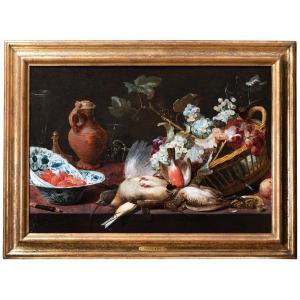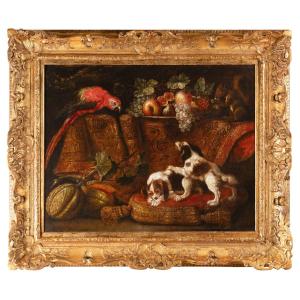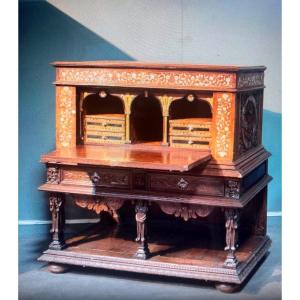Painted panels:
Circle of Hendrick van Balen (Antwerp, 1573–1632)
Antwerp, circa 1630, 17th century
Dimensions: h. 86 cm, l. 102 cm, p. 47cm
This precious cabinet is one of the rare, emblematic works of the city of Antwerp, produced thanks to the collaboration between a painter and a master cabinetmaker, and intended to adorn Kunstkammers (private museums) or art lovers' cabinets.
Our cabinet is decorated with 13 painted panels with mythological and allegorical subjects and perfectly reflects the Antwerp pictorial trends of the early 17th century. Definitely in the spirit of the times, where one of the roles of amateur cabinets (the room for which it is intended) is to be able to contemplate the world in all its aspects.
It opens with two doors revealing 10 drawers, 9 of which have painted panels on the front, a central door and an upper compartment whose interior is also decorated with a painted panel.
The left door presents a theme frequently treated in the 17th century, the allegory of the four elements that make up the universe: air, water, fire and earth. They are personified by young women displaying the attributes of the four kingdoms of nature. The armillary sphere for Air, a lit torch for Fire, the flowerpot for Earth and an urn for Water. In the foreground on the ground are placed objects evoking the art of fire: a pile of pieces of armor and weapons, on a table clocks and dishes. In the background we see Vulcan's forge.
The door on the right illustrates the allegory of Autumn in the guise of Roman divinities. Bacchus with a cup, Ceres with the cornucopia and Venus seen from the back and naked are gathered in a landscape while Diana presents them with the game. The fruits and vegetables placed at their feet evoke the richness of the harvest.
The small central door illustrates the Allegory of Vanity, personified by a young woman holding an oil lamp from which smoke escapes (the flight of time), the putto blowing soap bubbles (signifying the fragility of life) is seated on a skull, symbol of death.
The panel in the upper compartment illustrates the allegory of the five senses personified by young women gathered around a table filled with various dishes and each holding an attribute. The parrot for Touch, the mirror for Sight, the cup for Taste, the flower for Smell and the lute for Hearing.
This representation of the world through a cabinet continues with the choice of subjects used for the drawer panels which are directly inspired by Ovid's Metamorphoses engraved by Antonio Tempesta. These engravings published in 1606 considerably increased the mythological pictorial repertoire and quickly became the source of inspiration for Antwerp artists.
The subjects present:
Left side from top to bottom:
• Vertumnus and Pomona
• Apollo pursuing Daphne
• The suicide of Thysbe
• The death of Adonis
Right side from top to bottom:
• Procris Offering the Javelin of Artemis to Cephalus
• Adonis Contemplating the Sleeping Venus
• Latona Transforming the Lycian Peasants into Frogs
• Ceneus and Poseidon
The Central Drawer: Glaucus Seduced by Scylla
The stories contained in “The Metamorphoses” were perfectly suited subjects for cabinets of curiosities whose function was to reflect and explain the world and its origins through a mythological, not a biblical, vision.
Related works:
- cabinet with almost identical paintings of the circle of Hendrick Van Balen, was sold at Christie's London, 27/10/2015, lot 226.
- cabinet attributed to Hendrick Van Balen, sold at Christie's London on December 8, 2011, lot no. 107, some of whose panels are very similar to ours (the allegory of Vanity, Glaucus seduced by Scylla, Pomona and Vertumnus).
- The Philadelphia Museum of Art (USA) posseses a series of small panels by Hendrick Van Balen from a cabinet, two of which have the same subject and are similar to our panels.
In addition to the fabulous painted decoration, our cabinet is executed with refinement and use of expensive materials. It displays a sober but neat exterior, in ebony veneer and embellished with frames of wavy moldings and appliquéd silver applications. Once opened, the small door reveals a compartment composed of a series of drawers framing a theater designed by alternating mirrors and half-columns in gilded wood with at the bottom two paintings on wood representing an elegantly dressed gentleman and noble lady. The floor is a checkerboard of ebony and ivory.
Following the classical design, it has two drawers in the belt.
Historical context:
In the 17th century, Antwerp was the leading European center for the manufacture of cabinets with painted panels. Illustrations of contemporary interiors show that these were presentation furniture, often in ebony veneer on the outside which once opened amazed by the richness of their small oil paintings. These cabinets were intended to house collections of jewelry, silver, minerals, shells and other specimens, in keeping with the princely tradition of kunstkammer (private museums).
For example, we find a similar cabinet in a painting by Frans Francken's workshop "Achilles among the daughters of Lycomedes" dated to the end of the 1620s ( Musée du Louvre, Paris inv. RF1535 ). Among all the riches that the merchants brought to the king of Lycomedes, there is an ebony cabinet with painted panels.
It is obvious that a cabinet as the one we're offreing was one of the centerpieces of amateur cabinets and thanks to its many drawers an ideal place for storing all the precious objects belonging to collectors.


















































 Le Magazine de PROANTIC
Le Magazine de PROANTIC TRÉSORS Magazine
TRÉSORS Magazine Rivista Artiquariato
Rivista Artiquariato